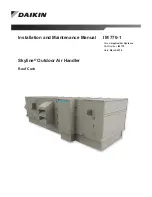
Piping and Connections
48
CLCH-SVX013B-EN
•
Ball shutoff valves.
Adding manual, ball-type shutoff
valves upstream and downstream of the filter
simplifies replacement of the filter core.
Suction Lines
Line sizing
Proper line sizing is required to guarantee the oil returns to
the compressor throughout the system’s operating
envelope. At the same time, the line must be sized so that
the pressure drop does not excessively affect capacity or
efficiency. To accomplish both objectives, it may be
necessary to use two different line diameters: one for the
horizontal run and for the vertical drops, and another for
the vertical lifts (risers).
Routing
To prevent residual or condensed refrigerant from “free-
flowing” toward the compressor during the off cycle,
install the suction line so it slopes by ¼ inch to 1 inch per
10 feet of run toward the evaporator.
When the application includes a suction riser, oil must be
forced to travel the height of the riser. Riser traps are
unnecessary in the suction line. They will add pressure
drop. Double risers must not be used. They not only add
pressure drop, but can hold great amounts of oil - oil better
used in the compressor.
If a suction riser is properly sized, oil will return to the
compressor regardless of whether a trap is present. If a
suction riser is oversized, adding a trap will not restore
proper oil entrainment.
Avoid Underground Refrigerant Lines
Refrigerant condensation during the off cycle, installation
debris inside the line (including condensed ambient
moisture), service access, and abrasion/corrosion can
quickly impair reliability.
Insulation
Any heat that transfers from the surrounding air to the
cooler suction lines increases the load on the condenser
(reducing the system’s air-conditioning capacity) and
promotes condensate formation. After operating the
system and testing all fittings and joints to verify that the
system is leak-free, insulate suction lines to prevent heat
gain and unwanted condensation.
Components
Installing the suction line requires field installation of
these components: a filter, access port, and a Frostat™
control when the refrigerant coil is used with Trane
condensing units. Position them as close to the
compressor as possible.
Note:
Placement of the Frostat control is illustrated in
.
•
Filter.
The suction filter prevents contaminants,
introduced during installation, from entering the
compressor. For this reason, the suction filter should
be the replaceable-core type,
and
a clean core should
be installed after the system is cleaned up.
•
Access port.
The access port is used to determine
suction pressure. This port is usually a Schraeder valve
with a core.
•
Frostat™ coil frost protection.
The Frostat control is the
preferred method for protecting evaporator coils from
freezing when the refrigerant coil is used with Trane
condensing units. It senses the suction-line
temperature and temporarily disables mechanical
cooling if it detects frost conditions. The control is
mechanically attached to the outside of the refrigerant
line, near the evaporator, and wired to the unit control
panel.
•
Ball shutoff valve.
Adding manual, ball-type shutoff
valves upstream and downstream of the filter
simplifies replacement of the filter core.
Expansion Valves
Expansion valves meter refrigerant into the evaporator
under controlled conditions. If there is too much
refrigerant, the refrigerant will not completely vaporize
and the remaining liquid will slug the compressor. If there
is too little refrigerant, there may not be enough cooling
for the compressor.
Expansion valve requirements vary based on condensing
unit design. Consult the product literature for the
condensing unit to be used for proper valve selection.
Hot Gas Bypass
Many years ago, hot gas bypass (HGBP) was successfully
added to HVAC systems to correct a number of operational
problems. Hoping to avoid such problems altogether, it
eventually became common practice for designers to
specify hot gas bypass in new systems. Unfortunately, the
practice often degraded rather than improved reliability.
Hot gas bypass increases the minimum refrigerant charge;
it also inflates the first cost of the system. Besides adding
more paths for potential refrigerant leaks, hot gas bypass
increases the likelihood of refrigerant distribution
problems. Finally, hot gas bypass uses excessive amounts
of energy by preventing the compressors from cycling
with fluctuating loads.
Trane now has many years of experience in the successful
use of equipment
without hot gas bypass
in commercial
comfort-cooling applications. To prevent evaporator
freeze-up, Trane equipment typically includes Frostat™
coil frost protection.
Like hot gas bypass, the Frostat system protects the coil
from freezing, but it does so by turning off compressors
when a sensor detects the formation of frost on the
evaporator coil. The compressor is released to operate
when the coil temperature rises a few degrees above the
frost threshold. The Frostat control strategy reduces the
Summary of Contents for Performance Climate Changer PSCA
Page 81: ......














































